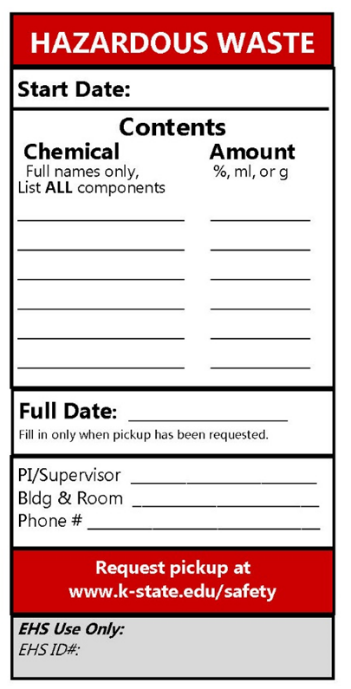Hazardous Waste Storage Requirements
Satellite Accumulation Areas
A satellite accumulation area is an area at or near any point of generation where hazardous waste initially accumulates. This may be in a lab, shop or classroom. The following hazardous waste storage requirements must be followed:
1. Containers must be compatible with the waste they contain.
- Do not use metal containers for corrosive wastes
- Do not use glass containers for hydrofluoric acid
2. Containers must be labelled with the following information:
- Marked with the words “Hazardous Waste”
- Description of the waste (i.e. full chemical names, not formulas or abbreviations)
- Date waste was first added to the container (Start Date)
Hazardous Waste labels are available from Environmental Health and Safety (EHS), call 785-532-5856.

3.
Containers must remain closed except when waste is being added or removed. Securely close container immediately after waste is added. Open-top funnels may not be left in container openings
4. Containers must be in good condition and not leaking. Containers must not have severe rusting, dents, or other conditions which could cause leaks or other unsafe conditions
5. Use only one storage container per waste stream (same chemical or mixture).
- Consolidate small vials and test tubes of the same waste into one container
- Each storage container must not exceed 55 gallons per SAA
6. Containers must be stored at or near the point of generation. Waste must remain in the same room that it is generated in and under the control of the generator of the waste. Select an area to accumulate hazardous waste.
7. Store liquid waste in secondary containment (such as trays or buckets) that are able to hold 110% of the contents of the largest waste container, to contain any spillage and to ensure segregation of incompatible waste.
8. Containers must be segregated by chemical compatibility during storage. Segregation can be achieved by physical distance or by using secondary containment. Avoid mixing waste streams e.g., acids and bases, aqueous solutions and organic solvents in the same container. Collect mercury compounds, highly toxic, and reactive wastes separately.
Hazardous Waste Disposal
To have waste removed from the SAA, go to www.ksu.edu/safety/environmental/hazardous-waste/pickup.html and complete the Hazardous Waste Pickup Request Form. Date the container with the Full Date. Containers must be removed within three days of Full Date.
EHS personnel will not transport unsafe containers.